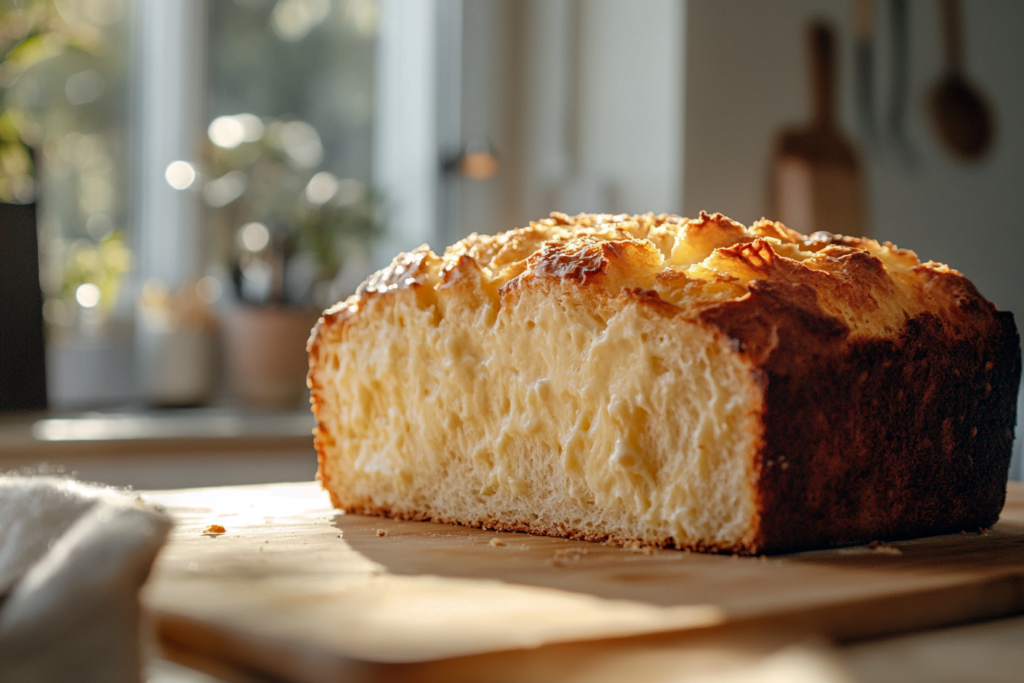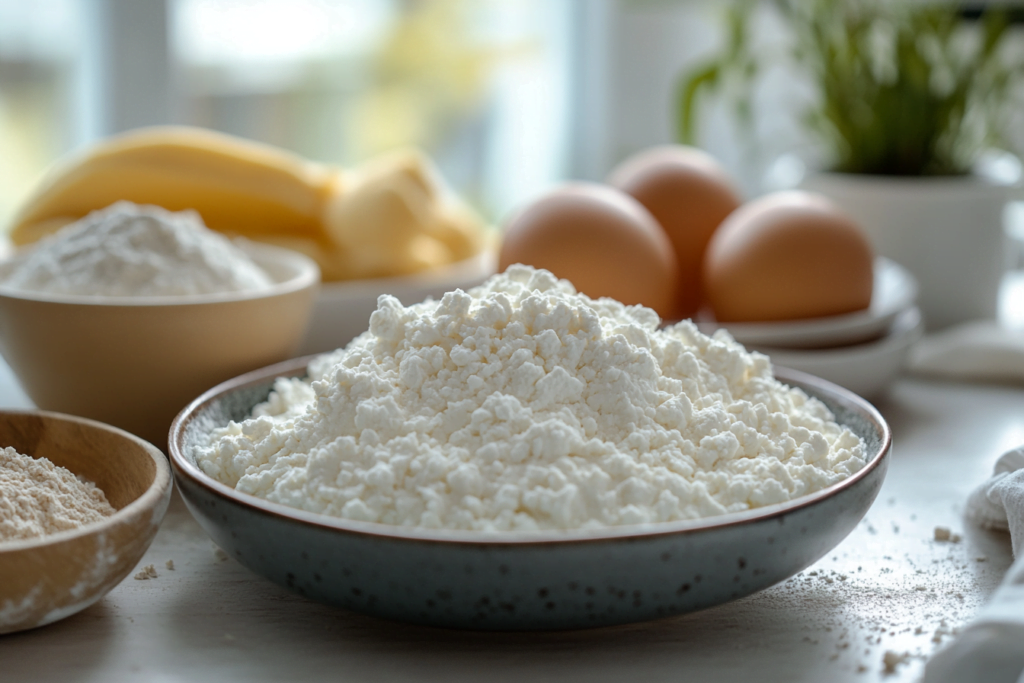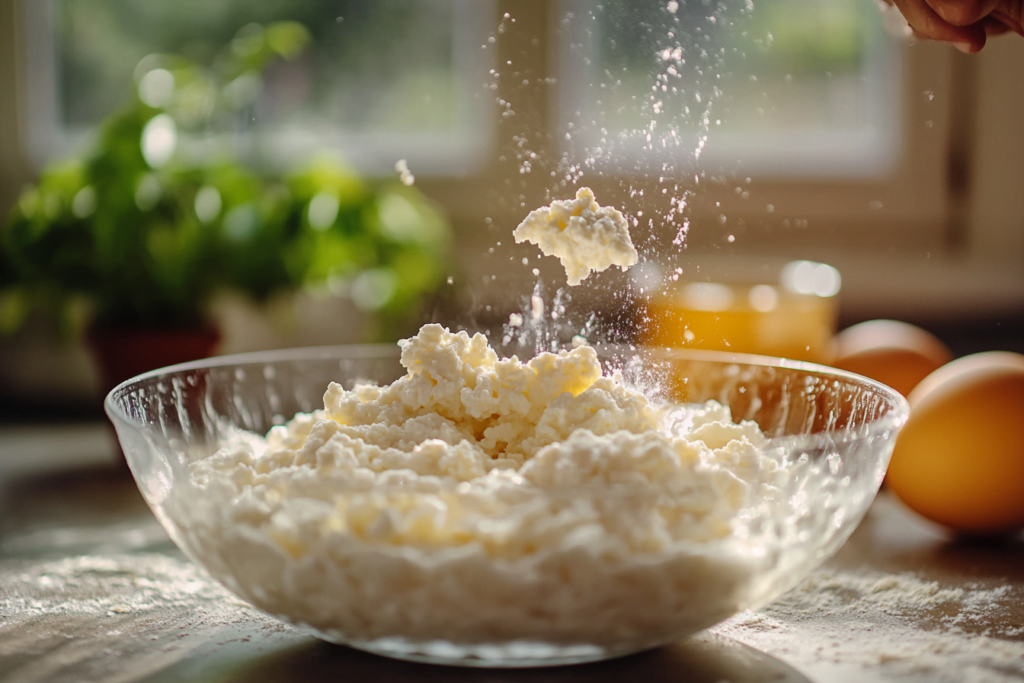Bread lovers, get ready for a wholesome and satisfying twist on traditional loaves! If you’ve been searching for a low-carb option that doesn’t compromise on taste or texture, this cottage cheese bread recipe is a game changer. Packed with protein and incredibly simple to make, it’s the perfect addition to your kitchen repertoire, especially for busy parents, home cooks, and anyone looking to add a nutritious touch to their meals.
What makes this bread so special is its unique use of cottage cheese. Not only does it provide a soft, moist crumb, but it also delivers a significant protein boost without the carbs often found in typical bread recipes. With just a few staple ingredients, you can whip up a loaf that’s ideal for sandwiches, toast, or simply enjoyed on its own.
Whether you’re new to baking or a seasoned pro, this recipe ensures you can bake with confidence. It’s suitable for everyone, from diet-conscious individuals to busy professionals who need quick, healthy meal options. In the following sections, we’ll dive into the step-by-step process, tips for success, and nutritional benefits of this incredible cottage cheese bread. So, grab your ingredients and let’s get started!

Why Cottage Cheese Bread Stands Out
Cottage cheese bread brings a distinct charm that sets it apart from your usual bread varieties. Unlike traditional loaves, which often rely heavily on flour, this bread incorporates cottage cheese as a primary ingredient, giving it a tender, moist texture and a high protein content. This makes it an excellent option for those looking to reduce their carbohydrate intake while still enjoying the taste and feel of bread.
What is different about cottage cheese bread? Its secret lies in its structure. Traditionally, this type of bread was shaped in a “cottage loaf” style, a classic English technique where one boule is stacked on top of another, helping bakers save space in their ovens. The result is a rustic-looking loaf with a dense crumb and a slightly chewy, golden crust.
The use of cottage cheese adds a mild, creamy flavor that pairs well with both savory and sweet toppings, making it incredibly versatile. Plus, it’s a great way to pack in extra protein without needing to rely on flour or other high-carb ingredients.
Key Features of Cottage Cheese Bread:
- High protein content from cottage cheese
- Low-carb, making it keto-friendly
- Tender crumb with a golden, chewy crust
- Easy to make with simple ingredients
This loaf is perfect for anyone looking to enjoy bread without the usual guilt. Whether you’re on a low-carb diet or simply looking for a healthier alternative, cottage cheese bread is a must-try.

Ingredients You’ll Need for Cottage Cheese Bread
Creating cottage cheese bread at home doesn’t require fancy ingredients or specialized equipment. In fact, you’ll likely have most of these items already in your kitchen. Here’s what you’ll need to get started:
| Ingredient | Measurement |
|---|---|
| Cottage Cheese (Full-fat or Low-fat) | 1 cup |
| Egg Whites | 4 large |
| Bread Flour or Almond Flour (for keto version) | 3 cups |
| Baking Soda | 1/2 teaspoon |
| Salt | 1 teaspoon |
| Active Dry Yeast | 2 1/2 teaspoons |
If you’re on a strict keto diet, opt for almond flour as a substitute for bread flour. While the original recipe calls for bread flour, the almond flour version will significantly reduce the carb content while keeping the texture light and fluffy.
Pro tip: Always use full-fat cottage cheese to achieve a creamy texture and moist crumb. If you’re watching your fat intake, low-fat cottage cheese works well, though it might add slightly more carbs.
Step-by-Step Guide to Baking Cottage Cheese Bread
Now that you have your ingredients ready, let’s dive into the process of baking your very own cottage cheese bread. Don’t worry if you’re not an experienced baker—this recipe is designed to be straightforward and beginner-friendly. Whether you’re using a bread machine or baking by hand, the steps are simple and easy to follow.
1. Preparing the Dough
- Start by blooming the yeast. Combine the active dry yeast with lukewarm water (around 110°F) and a pinch of sugar. Let it sit for 5 to 10 minutes until the mixture becomes foamy. This step ensures that your yeast is active and ready to work.
- Next, blend the cottage cheese and egg whites until smooth. This will create a creamy base for your dough, adding moisture and protein without the need for extra fat or flour.
- In a large mixing bowl, combine the blended cottage cheese mixture with the bloomed yeast. Add in the flour (or almond flour for the keto version), baking soda, and salt. Stir until a sticky dough forms.
2. Kneading the Dough
- Turn the dough out onto a lightly floured surface and begin kneading. If the dough is too sticky, gradually add more flour, one tablespoon at a time, until it’s workable but still soft.
- Knead for about 5 to 7 minutes, or until the dough becomes smooth and elastic. Kneading helps develop the gluten in the flour, giving the bread its structure and chewiness.
3. First Proofing
- Place the dough in a lightly greased bowl, cover with a damp cloth, and let it rise in a warm, draft-free spot for about 1 hour. The dough should double in size.
4. Shaping the Loaf
- Once the dough has risen, gently punch it down to release any air bubbles. Shape it into a loaf and place it in a greased loaf pan or shape it by hand for a more rustic, freeform look.
- If you want to create the traditional “cottage loaf” look, shape two boules—one smaller than the other—and stack them, pinching the dough where they meet.
5. Final Proofing
- Cover the shaped loaf and let it rise again for about 30 minutes to 1 hour. This second proofing ensures the bread has a nice, fluffy texture once baked.
6. Baking the Bread
- Preheat your oven to 400°F (200°C). Bake the loaf for 35 to 45 minutes, or until the top is golden brown and the bread sounds hollow when tapped on the bottom.
- Allow the bread to cool completely before slicing to ensure the crumb sets properly.
Tip: For an extra crispy crust, place a pan of water in the oven while the bread bakes. The steam will create a beautiful crust without drying out the loaf.

Why Cottage Cheese is a Healthy Choice
Cottage cheese is not just a star in this bread recipe—it’s also a nutritional powerhouse. It’s low in carbohydrates and packed with protein, making it a great option for those following low-carb or ketogenic diets. But is cottage cheese healthy or fattening? Let’s explore the benefits.
1. High in Protein, Low in Carbs
- Cottage cheese contains about 11 grams of protein per 100 grams, which makes it an excellent source of this essential nutrient. Protein is crucial for muscle repair, satiety, and overall bodily function.
- In terms of carbs, plain, full-fat cottage cheese contains only around 3 to 5 grams of carbohydrates per serving, making it a low-carb option. However, be mindful when selecting low-fat or fat-free varieties, as they often contain added sugars, increasing the carb content.
2. Rich in Calcium and Nutrients
- Cottage cheese is a fantastic source of calcium, contributing to stronger bones and teeth. One serving can provide up to 10% of your daily calcium needs.
- It’s also rich in other vital nutrients like vitamin B12, phosphorus, and selenium, all of which play important roles in maintaining a healthy body.
3. Versatile and Diet-Friendly
- Because of its mild flavor and creamy texture, cottage cheese can easily replace higher-fat ingredients in various recipes. Consider using it in place of sour cream, mayonnaise, or cream cheese to reduce saturated fat intake while keeping the dish delicious.
So, how many times a week should you eat cottage cheese? While it’s a great source of nutrition, balance is key. Experts recommend enjoying cottage cheese in moderation—about 1 cup per day is ideal to ensure you’re getting a variety of nutrients from other sources as well.

Serving Suggestions and Pairings for Cottage Cheese Bread
Cottage cheese bread is a versatile staple that pairs beautifully with a wide variety of dishes, making it an excellent choice for breakfast, lunch, or dinner. Whether you’re looking to create a savory sandwich or a sweet toast, this bread can easily adapt to your needs.
1. For Breakfast
- Top a slice with mashed avocado, a sprinkle of salt, and a drizzle of olive oil for a nutritious, trendy breakfast.
- Enjoy it as French toast by dipping slices in an egg mixture and pan-frying them until golden brown. Serve with maple syrup or fresh berries.
- Pair it with scrambled eggs and a side of smoked salmon for a protein-packed morning meal.
2. For Lunch or Dinner
- Use cottage cheese bread as the base for a hearty sandwich. Try layering it with turkey, fresh greens, and a slice of sharp cheddar for a satisfying midday meal.
- Serve it alongside a bowl of chili or stew, using the bread to soak up all the delicious flavors. Its slightly chewy texture makes it perfect for dipping.
- Transform it into garlic bread by brushing slices with olive oil and minced garlic, then toasting them in the oven until crispy. Serve with pasta dishes like spaghetti or fettuccine Alfredo.
3. For a Snack
- Spread cottage cheese bread with nut butter and a drizzle of honey for a quick, energy-boosting snack.
- Make a simple bruschetta by topping slices with chopped tomatoes, basil, and a splash of balsamic vinegar.
With these pairing ideas, cottage cheese bread can easily become a go-to item in your meal planning. Its high protein content and mild flavor allow it to complement a wide range of dishes, making it an ideal choice for any occasion.
How to Store and Freeze Cottage Cheese Bread
Proper storage is key to maintaining the freshness and texture of your cottage cheese bread. Luckily, this bread holds up well whether you’re keeping it for a few days or freezing it for longer-term storage. Here’s how to store it to make the most of your homemade loaf.
1. Storing at Room Temperature
- Once your bread has cooled completely, store it in an airtight container or wrap it tightly in plastic wrap. This will help prevent it from drying out and maintain its soft, moist texture.
- At room temperature, cottage cheese bread will stay fresh for about 2 to 3 days. If you plan to use it within this time frame, there’s no need to refrigerate it.
2. Freezing for Longer Storage
- For longer storage, freezing is an excellent option. Slice the bread before freezing to make it easy to grab individual portions later. Place parchment paper between the slices to prevent them from sticking together.
- Transfer the slices to a freezer-safe bag or airtight container. Frozen bread can last up to 1 month, retaining both its flavor and texture.
3. Reheating Frozen Bread
- To reheat frozen slices, simply pop them in the toaster for a quick and convenient option. The bread will come out warm and toasty, as if freshly baked.
- Alternatively, you can thaw slices at room temperature for about 30 minutes and then warm them in a preheated oven for 5 to 10 minutes.
By following these simple storage and freezing tips, you’ll be able to enjoy your cottage cheese bread whenever you like, whether it’s fresh from the oven or straight from the freezer.
Frequently Asked Questions about Cottage Cheese Bread
As more people discover the deliciousness and health benefits of cottage cheese bread, a few common questions arise. Here are the answers to some of the most frequently asked questions about this unique bread.
1. What is different about cottage cheese bread?
Cottage cheese bread stands out for its use of cottage cheese as a primary ingredient, which gives it a tender, moist crumb and adds a significant protein boost. Unlike traditional breads that rely on large amounts of flour, cottage cheese bread incorporates a softer, denser texture and a mild, creamy flavor. One of its distinct features is the “cottage loaf” shape, an old English baking technique where one boule is stacked on top of another to create a rustic, space-saving form.
2. Is cottage cheese low carb or high carb?
Plain, full-fat cottage cheese is relatively low in carbohydrates, containing about 3 to 5 grams per serving. This makes it an excellent choice for those following a low-carb or ketogenic diet. In contrast, low-fat or fat-free cottage cheese options may have more carbohydrates due to added sugars, so always check the label if you’re mindful of your carb intake.
3. Is cottage cheese healthy or fattening?
Cottage cheese is considered a healthy food, especially because it is high in protein and low in carbohydrates. It is also a rich source of calcium and other essential vitamins and minerals. When using full-fat cottage cheese, it provides healthy fats that support overall wellness. However, if you’re watching your saturated fat intake, opting for a low-fat version can still offer the same nutritional benefits while reducing fat content. Overall, cottage cheese is a great addition to a balanced diet.
4. How many times a week should you eat cottage cheese?
While cottage cheese is nutritious and beneficial, moderation is key to ensuring a balanced diet. Most experts recommend limiting your intake to about 1 cup per day to allow for nutrient variety. Additionally, comparing labels is important as some cottage cheese brands may contain higher sodium or sugar levels than others.
Final Tips for Baking Success
Baking cottage cheese bread can be a breeze if you follow a few simple tips and tricks. Whether you’re a first-time baker or a seasoned pro, these insights will help you achieve the perfect loaf every time.
1. Use Full-Fat Cottage Cheese
For the best results, it’s recommended to use full-fat cottage cheese. This adds creaminess and moisture to your bread, ensuring a soft and tender crumb. While low-fat options can be used, they might not produce the same rich texture and may add more carbohydrates due to added sugars.
2. Don’t Over-Knead the Dough
Over-kneading can result in a dense and tough loaf. Make sure to knead the dough just until it becomes smooth and elastic, typically 5 to 7 minutes. This will give the bread structure without compromising its softness.
3. Proofing is Key
Allowing the dough to rise twice is crucial for a fluffy, well-structured loaf. Skipping the second proofing can result in a denser bread. Make sure the dough doubles in size during the first rise and rises again after shaping for optimal results.
4. Cool Completely Before Slicing
While it may be tempting to slice into the loaf right out of the oven, letting it cool completely is essential. This ensures that the crumb sets properly and doesn’t collapse when cut. Patience will be rewarded with perfectly sliced bread.
By keeping these tips in mind, your cottage cheese bread will turn out beautifully, with a soft, chewy texture and a delicious golden crust. Don’t forget to enjoy it with your favorite spreads or as part of a hearty meal!
Conclusion
Cottage cheese bread offers a delightful balance between nutrition and flavor, making it an excellent addition to any meal. With its high protein content and low carbohydrate profile, it’s the perfect choice for those looking to enjoy bread without compromising on their health goals. Whether you’re enjoying it fresh out of the oven, paired with a savory soup, or toasted for a quick breakfast, cottage cheese bread is versatile and easy to make at home.
By following the step-by-step guide, using the right ingredients, and keeping storage tips in mind, you can enjoy this homemade bread for days—or even weeks—if you choose to freeze it. From busy parents to food enthusiasts, this recipe provides a simple yet rewarding way to bake healthier bread without the hassle.
So, the next time you’re in the mood for baking, why not try this cottage cheese bread recipe? You’ll be surprised at how easily it fits into your diet while adding a delicious new flavor to your kitchen.
Happy baking from Valentina Lewis at Valentina Recipes!

